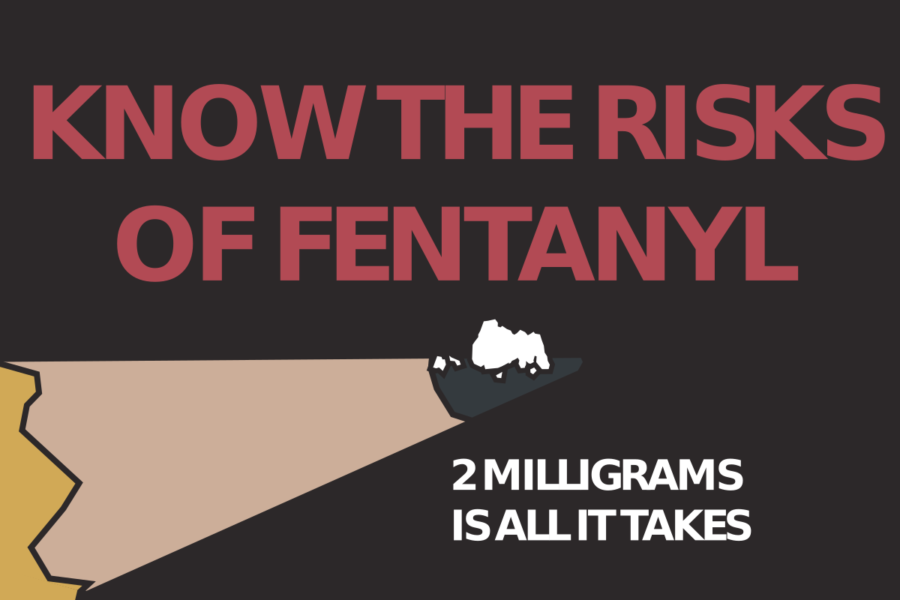Get the Facts Straight: Fentanyl
An informational article on fentanyl and it’s dangers
February 17, 2023
Fentanyl-related deaths in Texas have been on the rise in the past five years, nearly tripling between 2019 and 2020, according to the Texas Department of Health and Human Services. Despite this, not many people actually know what it is or what it does.
What is fentanyl?
Fentanyl is a synthetic opioid that is roughly 100 times stronger than morphine and nearly 50 times stronger than heroin. It was originally created as an alternative to morphine as an analgesic (pain reliever), because of its increased strength and apparent lack of side effects, according to an article in the Journal of Pain and Symptom Management.
Because fentanyl is also relatively cheap to produce, it is often mixed into other drugs, like heroin and oxycodone, without the knowledge of the people taking the drugs. This increases the risk of an overdose, since fentanyl is a much stronger drug than heroin or oxycodone.
What does fentanyl do?
Fentanyl, like other opioids, binds to the opioid receptors located throughout the brain and body. This floods the brain with dopamine, which causes an analgesic effect, as well as a sense of euphoria and extreme relaxation. This is similar to how other opioids function, but since fentanyl is much stronger than them, a smaller dose can cause a reaction that’s the same, or stronger, than a large dose of another opioid.
How does fentanyl affect people?
According to an article from the National Library of Medicine, since opioid receptors are located throughout the body, they can cause problems in many different parts of your body. These can include:
- Lowered breathing rate
- Lowered heart rate
- Constipation
- Reduced amount of hormones in your body – which can cause problems ranging from weak bones to a fever
- Reduced immune function
- Changes in your sleep schedule
- Altered mood
If any of these symptoms become severe enough, fentanyl can cause a coma or death.
How do people become addicted?
The limbic system originally evolved to reinforce behaviors that were necessary for survival by activating dopamine. But, when someone takes fentanyl, it releases a flood of dopamine that can be ten times greater than usual amounts of dopamine. The brain then remembers this surge of dopamine and associates it with fentanyl. If someone uses fentanyl more often to get that surge of dopamine, over time the brain will become less sensitive to dopamine and need a higher dose of fentanyl to achieve the same feeling.
Recognizing and Treating an Overdose
Being able to recognize a fentanyl overdose is extremely important with the rising cases of fentanyl-related deaths in Texas. All it takes is knowing a few of the tell-tale signs of an overdose to save somebody’s life. American Addiction Centers lists the following symptoms of an opioid overdose, including fentanyl:
- Constricted (very small) pupils
- Severe respiratory depression, such as slow or shallow breathing
- Cold, clammy skin
- Gray, blue or pale skin
- Blue or purple lips and nails
- Respiratory arrest (stopped breathing)
- Extreme decreases in the level of consciousness
- Limp or flimsy arms and legs
- Slurred speech or inability to speak
- Loss of consciousness
- Unresponsiveness
- Vomiting
- Making choking or gurgling sounds
It is important to know that a lot of symptoms of a drug overdose can overlap with other health issues. However, if you even have the slightest suspicion someone may be experiencing a drug overdose, it is crucial you get them immediate medical attention by dialing 911 and getting the help of a trusted adult.
If you believe someone may be having an overdose, follow these instructions according to the American Addiction Centers:
- Stay with the person to monitor their breathing
- To prevent choking, turn the person on their side
- If emergency personnel are not on-site, stay with the person until medical assistance arrives
Do not:
- Put the person in a cold shower or bath
- Forcefully slap the person to try and wake them
- Inject the person with any substance
- Attempt to make the person vomit, as it may increase their risk of aspiration or choking
Protection Under the Law
When you are helping someone experiencing an overdose, it’s important that you don’t endanger yourself. That’s why there are laws that protect citizens attempting to give medical attention to overdosing patients. The Good Samaritan Overdose Law, or the Jessica Sosa Act, is a law effective in Texas that ensures the safety of people calling an ambulance for an overdosing person/s if they meet all of the following conditions, according to Texas criminal defense lawyer George Roland:
- The person is first to call 911 during a possible drug overdose
- The person remains on scene until medical assistance arrives
- The person cooperates with medical assistant and law enforcement personnel
This law even applies to people who are also abusing substances, due to the fact that people weren’t calling the ambulance out of fear of legal repercussions. If somebody is under the influence and calls 911 for someone they believe is having a drug overdose, they will be provided defense in certain cases, with some exceptions. If you want to know more about this law, you can read more about it on this flier by the Houston Recovery Center.









